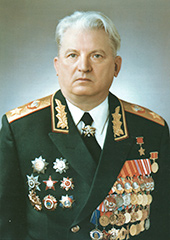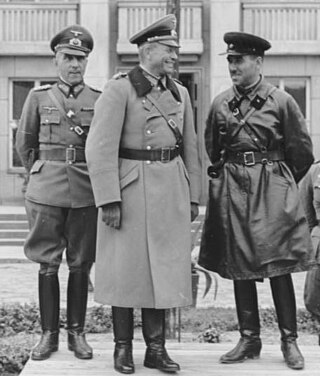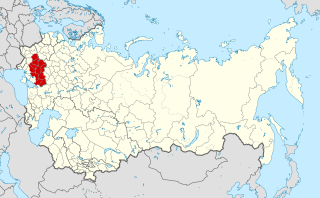
Semyon Konstantinovich Kurkotkin was a Soviet military commander and a Marshal of the Soviet Union.

Semyon Moiseevich Krivoshein was a Soviet tank commander, who played a vital part in the World War II reform of the Red Army tank forces and in the momentous clash between German and Soviet tanks in the Battle of Kursk.
A tank corps was a type of Soviet armoured formation used during World War II.

The Kiev Military District was a military district of the Imperial Russian Army and subsequently of the Red Army and Soviet Armed Forces. It was first formed in 1862, and was headquartered in Kiev (Kyiv) for most of its existence.
The 78th Rifle Division was an infantry division of the Red Army, formed in 1932, in Novosibirsk, in the Siberian Military District. After being used to provide cadres for new divisions, in September 1939 the division was reformed for the second time. In 1940 the division was transferred to Khabarovsk in the Far Eastern Front.

The 11th Guards Army was a field army of the Red Army, the Soviet Ground Forces, and the Russian Ground Forces, active from 1943 to 1997.
The 1st Mechanized Corps was a mechanized corps of the Red Army during World War II that formed twice.

The 28th Army was a field army of the Red Army and the Soviet Ground Forces, formed three times in 1941–42 and active during the postwar period for many years in the Belorussian Military District.

The 4th Guards Tank Army was an operational military unit within the Armed Forces of the Soviet Union during the Great Patriotic War and in the post–war period.
The 79th Guards Rifle Division was an infantry division of the Red Army during World War II.
The 11th Tank Division was a Soviet tank division initially formed in 1940 at Tiraspol and destroyed in 1941; it was then formed as a tank corps in May 1942. This unit was subsequently reorganized as the second formation of the 11th Tank Division in 1945.

The 11th Guards Mechanized Brigade is a unit of the Armed Forces of Belarus based in Slonim. The 11th Guards Brigade traces its history back to the 1942 formation of the 6th Tank Corps of the Soviet Army during World War II.
The 13th Guards Army Corps was a corps of the Soviet Ground Forces, formed from the previous 13th Guards Rifle Corps, which saw service during the Second World War.

The Red Banner Ural Military District was an operational–strategic territorial association of the Armed Forces of the Soviet Union and the Russian Federation, which existed in 1918–1922, 1935–1989 and 1992–2001.

The 5th Guards Cavalry Division was a military unit in the Workers' and Peasants' Red Army of the Union of Soviet Socialist Republics in the Great Patriotic War.
The 467th Guards District Training Center for Junior Specialists of the Moscow Military District is a training formation of the Russian Ground Forces.
The 53rd Rifle Division was an infantry division of the Red Army that served from the early 1930s to the immediate postwar period following World War II.
The 366th Rifle Division was an infantry division of the Red Army during World War II, formed twice.
The 35th Guards Rifle Corps was a rifle corps of the Red Army during World War II that became part of the Soviet Army during the Cold War.
The 108th Anti-Aircraft Missile Regiment was an air defense regiment of the Ukrainian Air Force, based at Zolotonosha until its 2012 disbandment. The regiment began as the 22nd Anti-Aircraft Artillery Division of the Red Army formed during World War II, which was reorganized as a brigade postwar. During much of the Cold War it was the 108th Anti-Aircraft Missile Brigade.










